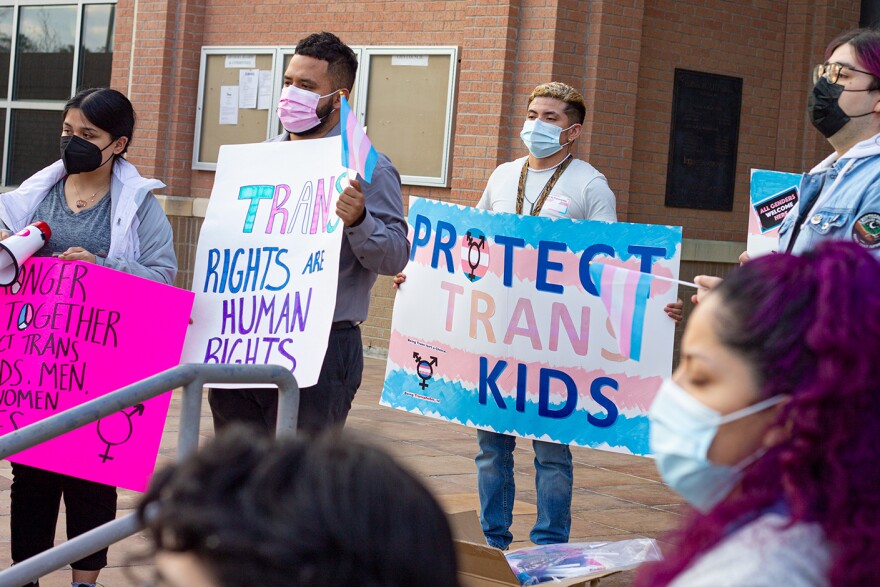Trans people and Trans rights have been in the headlines for some time now. There are many misconceptions surrounding those who are not comfortable with their sex assigned at birth, which leads to a discussion of gender dysphoria. What is gender dysphoria? How is it viewed within the medical and mental health professions? And why does it happen? TPR's Jerry Clayton recently spoke with Dr. Shelby Scott, an assistant professor of psychology at the University of Texas at San Antonio and director of the Pride Family Studies Lab, about gender dysphoria.
This conversation has been edited and condensed for length and clarity
Clayton: Well, let's start with the basics. What is gender dysphoria?
Scott: So gender dysphoria refers to feelings of distress or discomfort that some people experience because their gender identity, meaning they're their innate inner sense of gender differs from their sex assigned at birth.
This can happen in a few different ways, including socially, so experiencing distress because society views your gender in a way that is not consistent with your inner sense of gender. It can involve physical aspects in which your body different body parts due to your sex assigned at birth don't align with your inner sense of gender.
Clayton: Can you explain the difference between Trans and Nonbinary?
Scott: So transgender is an umbrella term that encompasses a host of different identities where people feel that their gender identity in some way differs from their sex assigned at birth. So under the transgender umbrella, you have identities that might include being a transgender woman or transgender man that might kind of identify on the binary, you know, one side or the other of gender identity.
And then you also have a host of identities that go under this nonbinary category that either reject binary notions of gender or where you might have people who identify as both female and male, identify as neither, identify as somewhere in between their identities under that umbrella term that include things like gender-fluid, gender-nonconforming, those kind of identities. But transgender is the larger umbrella term. However, I should mention some nonbinary people don't identify as transgender. They kind of see that as a different identity. So it's pretty complex and nuanced
Clayton: Is gender dysphoria recognized as a mental condition?
Scott: So this is a great question that has received a lot of debate and controversy in the mental health field as well as medical field. Gender dysphoria is also considered at this time a diagnostic category in the DSM-5, which is the Diagnostic and Statistical Manual of Mental Health Disorders. However, gender dysphoria replaced what used to be referred to as gender identity disorder. And in many ways, this this change in terminology was decided upon as a way to de-pathologize being transgender.
In other words, there is nothing inherently pathological about being transgender or non-binary. It's the stress of having other people in society misperceive your gender that can lead to emotional distress and psychological distress or having, you know, different body parts that don't align with your inner sense of gender.
So the DSM-5 continues to have this term gender dysphoria as a way to acknowledge that distress, which is very useful in terms of being able to then offer appropriate clinical services and medical services to relieve that distress.
Clayton: How much research has been done into what causes this to happen with an individual?
Scott: The truth is this is a really emerging field where we still don't know. It's similar in many ways to questions about sexual orientation. Likely there are genetic and biological components that predispose someone to be transgender or non-binary.
What we do know, however, is that most individuals, transgender or cisgender, which refers to folks whose gender identity matches their sex assigned at birth, most individuals report having a sense of their gender from a very young age. So typically between ages two and four, young children start to develop this inner sense of just knowing their gender.
And we find in most transgender people, they report having experienced some level of gender dysphoria before the age of seven. These are on studies on transgender women and transgender men. So there is definitely a component that is there from a very early age that contributes to your sense of gender and your sense of knowing what that is, that can't be explained by societal pressure or societal influences.
Copyright 2023 Texas Public Radio. To see more, visit Texas Public Radio. 9(MDA4OTAxNzAzMDEzMjc0MTc2MzA5ZDZlMw004))








